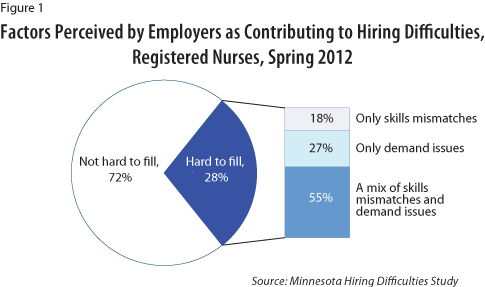
By Alessia Leibert
March 2013
A new DEED study found that a lack of skilled candidates is a small factor in the inability of employers to fill openings for registered nurses. Unfavorable characteristics related to the job, firm or industry and geographic mismatches are often bigger contributors to hiring challenges in the field.
Skills mismatches occur when there is a gap between supply and demand for a particular skill, resulting in unfilled job vacancies and significantly slower hiring. Where skill gaps do, in fact, result in inadequate staffing, additional workforce training or education could spur economic growth. There are other reasons, however, that vacancies may go unfilled, including factors unrelated to the candidate pool such as uncompetitive compensation packages, ineffective recruitment strategies, and unattractive job requirements.
Where skills are scarce we expect to see hiring difficulties across a variety of industries, regions, and job characteristics for vacancies within the same occupation. Moreover, we would expect jobs requiring more skills and experience to be harder to fill overall than entry-level jobs within the same occupation.
DEED's Hiring Difficulties Survey last fall looked at employers' perceptions of hiring difficulties by occupation and compared them with a variety of firm and job characteristics. Six occupations were chosen based on available anecdotal evidence of hiring difficulties. This article, focusing on survey findings for the registered nurse (RN) occupation, is the first in a series of reports on different occupations.
In order to identify hiring difficulties, employers were first asked the following question: "Did you have/Are you having difficulties filling the position?" Those who reported difficulties were asked to identify the reasons. Was hiring difficulty driven by a lack of training, skills or experience of applicants or demand factors unrelated to the candidate pool, including unattractive work hours, wages, or geographic location?
As illustrated in Figure 1, 28 percent of RN vacancies were reported as hard to fill during second quarter 2012. This section will focus on this group of RN vacancies.
According to the human resource professionals who were interviewed, skills deficiencies rarely occur in isolation from demand-side factors. Of the hard-to-fill vacancies, only 18 percent fell into this category exclusively because candidates did not have the qualifications required. The majority, 55 percent, fell into this category due to a combination of skills mismatches and unattractive demand characteristics.

Moreover, when skills mismatches were cited as a problem, employers cited insufficient experience in a specific role or industry rather than insufficient formal education in the candidate pool. The following quotes illustrate this finding:
If the problem is a mismatch between the experience requirements of vacancies and the experience profile of the candidate pool, the solution is not more schooling but more cross-functional work-based learning to increase the transferability of skills.
When demand-side factors were cited as a problem, undesirable location was most frequently mentioned, followed by uncompetitive wages or compensation in general, work shifts, and competition from other employers who invest more resources in attracting candidates. The following quotes illustrate this point:
Recruiters are very much aware of what else could be done to improve the quantity and quality of the applicant pool. In fact, the strategies they've used in the past and plan to use if hiring difficulties persist, address precisely these issues. Here are some insightful ideas collected from respondents:
Most hiring difficulties did not prevent employers from hiring successfully. Fifty-six percent of positions reported as hard to fill were filled successfully by the time the interviews were conducted, about three to eight months after the job was posted.
Overall, survey results suggest that the difficulties employers face in finding adequately prepared candidates are strongly dependent on demand characteristics.2 The next section of the article explores these demand characteristics and their ability to explain hiring difficulties.
Table 1 categorizes firm and job factors associated with hiring difficulties as determined by the actual explanatory power they show when they are included in a model that predicts the probability of a vacancy being hard to fill. This analysis of 893 estimated RN vacancies reveals that factors such as firm location, firm size, and industry strongly affect the probability of a job being hard to fill.
| Incidence of Hiring Difficulties in RN Vacancies by Firm and Job Characteristics, Spring 20121 | ||
|---|---|---|
| Factor | Categories | % Hard to fill |
| Location of Firm** | Metro area | 22 |
| Greater Minnesota | 34 | |
| Size of Firm** | Small: Fewer than 50 employees | 1 |
| Medium: 50 to 249 employees | 52 | |
| Large: 250 or more employees | 30 | |
| Industry of Firm** | NAICS 621 Ambulatory Health Care Services | 27 |
| NAICS 622 Hospitals | 37 | |
| NAICS 623 Nursing and Residential Care Facilities | 47 | |
| Industries outside of health care | 7 | |
| Job Experience Requirements** | No experience required (entry-level) | 47 |
| Experience of less than three years | 19 | |
| More than three years of experience | 60 | |
| Job Education Requirements* | Associate degree | 27 |
| Bachelor's degree | 34 | |
| ** strong factor
* weak factor 1The model was able to correctly predict the presence or absence of a hiring difficulty in 84 percent of survey data, with a Nagelkerke R Square of .526. The following variables were included in the model: geography (six Planning Regions), firm size, industry, experience, education and interactions between industry and experience level. |
||
| Source: Minnesota Hiring Difficulties Study | ||
The effect of each factor is explained below.
Geographic location: The data show that the probability of a job being hard to fill increases by a factor of 8 in Greater Minnesota compared with the metro area.
Firm size: The probability of a job being hard to fill increases by a factor of 4 in midsized firms compared with large firms. Large health care establishments definitely have a recruiting advantage because they can advertise more, offer higher wages and learning opportunities, as well as hiring bonuses and other incentives to relocate. So firm size appears to be a proxy for compensation and other aspects that make a vacancy more or less attractive to applicants.
Industry: Results show that, compared with jobs in nursing care facilities, the probability of a vacancy being hard to fill decreases to almost zero (.04) if it occurs in ambulatory services or in industries outside of health care, and to one-third (.38) in hospitals. Although the effect of wage offers on hiring difficulties could not be measured,3 wage might be one of the reasons some industries are experiencing significantly more hiring difficulties than others. For example, long-term care facilities may have difficulty attracting and retaining nurses in part because they are not reimbursed at the same rates as hospitals and cannot always offer competitive wages. But compensation is not the only issue. Industry captures other underlying factors that influence a nurse's choice of where to work, including schedules, types of patients served, career development opportunities, etc. For example, ambulatory surgery centers might be less likely to experience hiring difficulties because of lower stress levels and no night, holiday, or weekend shifts.
Entry-level versus experienced jobs: The probability of a job being hard to fill drops to one- seventh (.14) if the job requires intermediate or high experience compared with no experience. Besides ambulatories and industries outside of health care, where high experience vacancies were fewer and harder to fill than others, nursing positions requiring experience generally are easier to fill than those requiring no experience. This finding undermines the argument of a skills gap in the RN occupation in that we would expect to see an increase in hiring difficulty in vacancies requiring higher levels of skill (including experience). It is important to note that employers are, in general, reluctant to train entry-level nurses because it entails additional resources including staff time of experienced RNs. It appears that many employers look for experienced candidates to fill even entry-level positions, which may explain some of the hiring difficulty associated with entry level RN positions.
Associate degree versus bachelor's degree jobs: Post-secondary education and licensure are absolute requirements for work in the RN field. Therefore, the education system plays an essential role in ensuring an adequate supply of new nursing graduates to meet growing levels of demand. Although some employers prefer a bachelor's over an associate degree, most look only at the RN license. Therefore, adding years of education beyond a license may not ease hiring difficulties. This finding provides evidence against a widespread skills gap for RNs.4
Poor supply of skills is the root cause of only a small fraction of hiring difficulties in the RN occupation. The quantitative analysis reveals a multitude of potential causes that, at a minimum, cautions against drawing conclusions about talent shortages. Hiring difficulties definitely occur, but they seem to be driven primarily by less-than-attractive job, firm, or industry characteristics, and location mismatches (demand-side factors), rather than by the lack of available occupational skills in the workforce. Quantitative evidence is also consistent with employers' perceptions of a complex mix of contributing factors. Because experience is such an important component of RN skills, both job seekers and employers have a role to play in closing the skills gap. Job seekers may be well guided to take less than ideal jobs in order to obtain experience. On the other hand, employers who do not offer meaningful development opportunities to their nursing workforce are at risk of losing the talent race. If the goal is to match workforce skills with employers' needs, both sides will have to adjust their expectations and commit to work-based learning.
|
Hiring Difficulties Survey Quick Facts Data collection method: in-depth phone interviews with employers who reported RN vacancies as part of the Minnesota Job Vacancy Survey, second quarter 2012. 100 establishments with 893 RN vacancies responded, representing a 78 percent response rate. Data collected for each establishment: geographic location, industry classification, employment size. Data collected for each job vacancy: number of openings, experience level, education level, part-time status. Survey questions for the measurement of hiring difficulties:
(Check all that apply.) a) There weren't enough applicants with the right type of education or training. b) There weren't enough applicants with the right skills, knowledge, or experience. c) The hiring difficulty was related to the wage being offered. d) The hiring difficulty was related to the geographic location of the work. e) The hiring difficulty was related to the hours or shifts of work. |
1One respondent who experienced hiring difficulties commented: "We think it might help to utilize some of our education partners and target schools to see if they have students that are interested in applying. Since part of the issue is our location (hard to get people to relocate or travel), it might help to target the schools in the area."
2The difficulties firms face in finding an adequate candidate pool also appear to be driven, in part, by ineffective recruiting strategies and by historically low geographic mobility of the workforce as a consequence of the real estate crash, but these aspects go beyond the scope of our survey.
3The effect of wage offers could not be measured because most employers can increase or decrease it as a response to anticipated market conditions. Thus, it is simultaneously a cause and an effect of hiring difficulties.
4This article focuses on registered nurses. Other nursing occupations requiring schooling beyond a bachelor's degree (nurse anesthetists and nurse practitioners) were not included in the analysis.